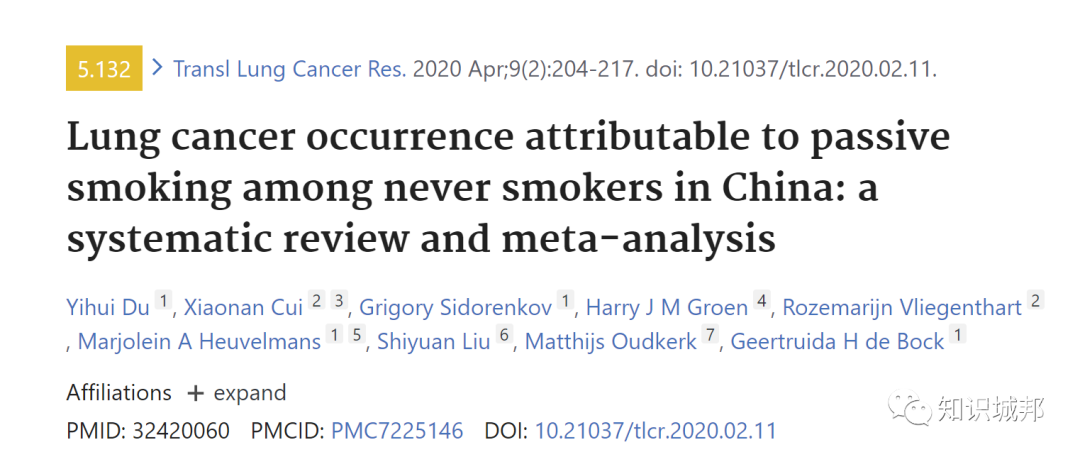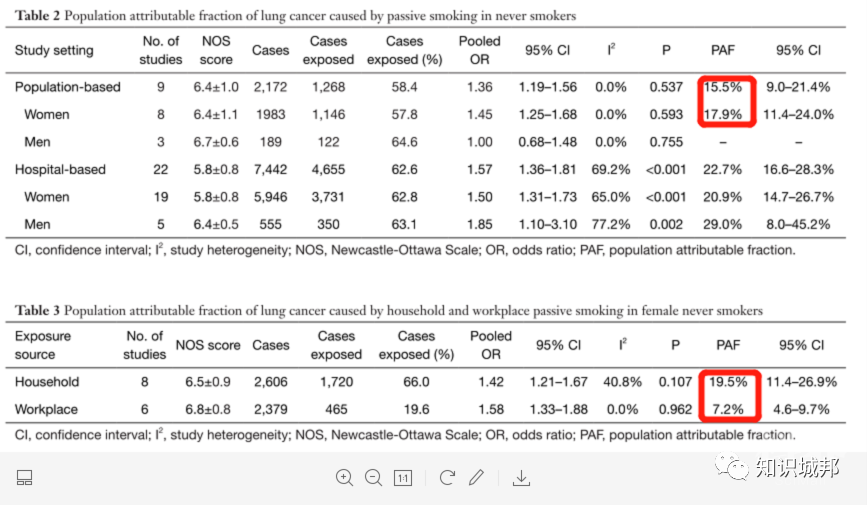科技工作者之家
科技工作者之家APP是专注科技人才,知识分享与人才交流的服务平台。
科技工作者之家 2020-09-23
来源:中华医学会胸心分会

点击上方蓝字关注我们
前言
很多人在体检筛查中发现肺部结节的时候,最常说的一句话就是“我也不抽烟啊!”
既然抽烟与肺癌发生的关系已经被大家熟知,那么从不抽烟的人(never-smoker)出现肺癌是因为什么呢?
一项分析了被动吸烟,也就是二手烟,在从不抽烟的中国人中与肺癌发生的关系的meta分析近期发表在TLCR上。


中国非吸烟者被动吸烟导致肺癌发生的系统回顾和meta分析
— 结论—
我们的结论是,在中国从不吸烟的人中,大约16%的肺癌病例可能与被动吸烟有关。这在女性中略高(约18%),大多数病例是由于家庭接触造成的。
— 背景—
在制定公共卫生政策时,量化被动吸烟导致的肺癌的发生是必要的一步。在这项研究中,我们估计了中国从不吸烟的人中可归因于被动吸烟的肺癌病例的比例。
Quantifying the occurrence of lung cancer due to passive smoking is a necessary step when forming public health policy. In this study, we estimated the proportion of lung cancer cases attributable to passive smoking among never smokers in China.
— 方法—
我们检索了截至2019年7月的6个数据库,寻找报告中国从不吸烟者与被动吸烟相关的肺癌发生的相对风险(RR)或优势比(OR)的观察性研究。然后使用暴露于被动吸烟的肺癌病例的组合比例和meta分析的合并OR计算人群归因分数(PAF)。数据以其95%的置信区间进行报告。
— 结果—
我们选取了31项从不吸烟者的病例对照研究,没有队列研究。其中包括9614例肺癌病例和13093例对照。在9项基于人群的研究和22项基于医院的研究中,被动吸烟导致肺癌的总比例分别为15.5%(9.0-21.4%)和22.7%(16.6-28.3%)。人群研究女性PAF为17.9%(11.4-24.0%),医院研究为20.9%(14.7-26.7%)。男性的PAF只在基于医院的研究中可计算,为29.0%(95%CI:8.0-45.2%)。在女性中,可归因于家庭暴露的肺癌病例百分比(19.5%)远远高于因工作场所暴露所致的肺癌病例百分比(7.2%)。

来源:知识城邦
作者:摇树小蚂蚁

来源:CSTCVS1985 中华医学会胸心分会
原文链接:https://mp.weixin.qq.com/s?__biz=MzA3NDQwNzQ3OA==&mid=2649079924&idx=4&sn=ac9b59e761bbfd54e6a0eb19c434ffd7&chksm=87112b2db066a23b4575f4882f4ec6827aa81613be217e745d764e34e5a54cc0b8b5d32e5c47#rd
版权声明:除非特别注明,本站所载内容来源于互联网、微信公众号等公开渠道,不代表本站观点,仅供参考、交流、公益传播之目的。转载的稿件版权归原作者或机构所有,如有侵权,请联系删除。
电话:(010)86409582
邮箱:kejie@scimall.org.cn

运动可降低肺癌手术后并发症风险

戒烟,值多少钱?

肺癌为什么会肩疼?肺癌引起的咳嗽有何特点

三种新的肺癌遗传生物标志物被发现

国际肺癌日 | 如何有效预防肺癌?这些知识你该知道

八成患者发现肺癌已是晚期,早期肺癌大多没有症状
肺结节就是肺癌吗?

中国研究型医院学会胸外科学专业委员会成立

肺癌大咖齐聚线上 共话肺癌精准诊疗|肺癌精准诊疗学术论坛精彩回顾
7成肺癌发现时是晚期 远离"五气"预防肺癌